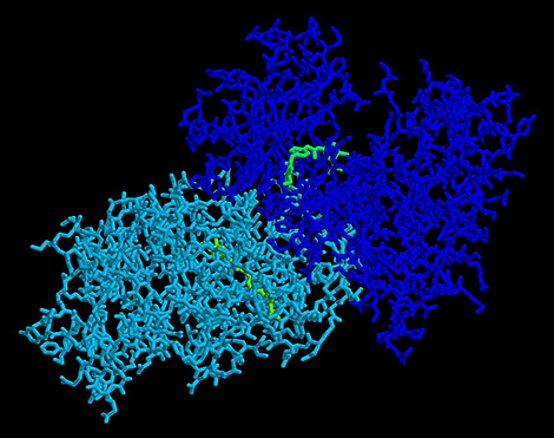| 2024 |
- Berfelde, J., Hildebrand, L. S., Kuhlmann, L., Fietkau, R., & Distel, L. V. (2024). FEN1 Inhibition as a Potential Novel Targeted Therapy against Breast Cancer and the Prognostic Relevance of FEN1. International Journal of Molecular Sciences, 25(4), 2110. https://www.mdpi.com/1422-0067/25/4/2110
- Klieber, N., Hildebrand, L. S., Faulhaber, E., Symank, J., Häck, N., Härtl, A., Fietkau, R., & Distel, L. V. (2024). Different Impacts of DNA-PK and mTOR Kinase Inhibitors in Combination with Ionizing Radiation on HNSCC and Normal Tissue Cells. Cells, 13(4), 304. https://www.mdpi.com/2073-4409/13/4/304
|
| 2023 |
- Fleischmann, J., Hildebrand, L. S., Kuhlmann, L., Fietkau, R., & Distel, L. V. (2023). The Effect of Xevinapant Combined with Ionizing Radiation on HNSCC and Normal Tissue Cells and the Impact of Xevinapant on Its Targeted Proteins cIAP1 and XIAP. Cells, 12(12), 1653. https://www.mdpi.com/2073-4409/12/12/1653
- Scheper, J., Hildebrand, L. S., Faulhaber, E.-M., Deloch, L., Gaipl, U. S., Symank, J., Fietkau, R., Distel, L. V., Hecht, M., & Jost, T. (2023). Tumor-specific radiosensitizing effect of the ATM inhibitor AZD0156 in melanoma cells with low toxicity to healthy fibroblasts. Strahlentherapie und Onkologie, 199(12), 1128-1139. https://doi.org/10.1007/s00066-022-02009-x
|
| 2022 |
- Jost, T., Schultz, A.-K., Frey, B., Vu, J., Fietkau, R., Distel, L. V., & Hecht, M. (2022). Influence of alectinib and crizotinib on ionizing radiation - in vitro analysis of ALK/ROS1-wildtype lung tissue cells. Neoplasia, 27, 100780. https://doi.org/https://doi.org/10.1016/j.neo.2022.100780
- Jost, T., Schuster, B., Heinzerling, L., Weissmann, T., Fietkau, R., Distel, L. V., & Hecht, M. (2022). Kinase inhibitors increase individual radiation sensitivity in normal cells of cancer patients. Strahlentherapie und Onkologie, 198(9), 838-848. https://doi.org/10.1007/s00066-022-01945-y
|
| 2021 |
- Faulhaber, E. M., Jost, T., Symank, J., Scheper, J., Bürkel, F., Fietkau, R., Hecht, M., & Distel, L. V. (2021). Kinase Inhibitors of DNA-PK, ATM and ATR in Combination with Ionizing Radiation Can Increase Tumor Cell Death in HNSCC Cells While Sparing Normal Tissue Cells. Genes (Basel), 12(6). https://doi.org/10.3390/genes12060925
- Jonuscheit, S., Jost, T., Gajdošová, F., Wrobel, M., Hecht, M., Fietkau, R., & Distel, L. (2021). PARP Inhibitors Talazoparib and Niraparib Sensitize Melanoma Cells to Ionizing Radiation. Genes, 12(6), 849. https://www.mdpi.com/2073-4425/12/6/849
- Jost, T., Heinzerling, L., Fietkau, R., Hecht, M., & Distel, L. V. (2021). Palbociclib Induces Senescence in Melanoma and Breast Cancer Cells and Leads to Additive Growth Arrest in Combination With Irradiation [Original Research]. Frontiers in Oncology, 11. https://doi.org/10.3389/fonc.2021.740002
|
| 2020 |
- Bürkel, F., Jost, T., Hecht, M., Heinzerling, L., Fietkau, R., & Distel, L. (2020). Dual mTOR/DNA-PK Inhibitor CC-115 Induces Cell Death in Melanoma Cells and Has Radiosensitizing Potential. Int J Mol Sci, 21(23). https://doi.org/10.3390/ijms21239321
- Dobler, C., Jost, T., Hecht, M., Fietkau, R., & Distel, L. (2020). Senescence Induction by Combined Ionizing Radiation and DNA Damage Response Inhibitors in Head and Neck Squamous Cell Carcinoma Cells. Cells, 9(9), 2012. https://www.mdpi.com/2073-4409/9/9/2012
- Weigert, V., Jost, T., Hecht, M., Knippertz, I., Heinzerling, L., Fietkau, R., & Distel, L. V. (2020). PARP inhibitors combined with ionizing radiation induce different effects in melanoma cells and healthy fibroblasts. BMC Cancer, 20(1), 775. https://doi.org/10.1186/s12885-020-07190-9
|
| 2018 |
- Hecht, M., Meier, F., Zimmer, L., Polat, B., Loquai, C., Weishaupt, C., Forschner, A., Gutzmer, R., Utikal, J. S., Goldinger, S. M., Geier, M., Hassel, J. C., Balermpas, P., Kiecker, F., Rauschenberg, R., Dietrich, U., Clemens, P., Berking, C., Grabenbauer, G., Heinzerling, L. (2018). Clinical outcome of concomitant vs interrupted BRAF inhibitor therapy during radiotherapy in melanoma patients. British Journal of Cancer, 118(6), 785-792. https://doi.org/10.1038/bjc.2017.489
- Stritzelberger, J., Distel, L., Buslei, R., Fietkau, R., & Putz, F. (2018). Acquired temozolomide resistance in human glioblastoma cell line U251 is caused by mismatch repair deficiency and can be overcome by lomustine. Clinical and Translational Oncology, 20(4), 508-516. https://doi.org/10.1007/s12094-017-1743-x
|
| 2017 |
- Gryc, T., Putz, F., Goerig, N., Ziegler, S., Fietkau, R., Distel, L. V., & Schuster, B. (2017). Idelalisib may have the potential to increase radiotherapy side effects. Radiation Oncology, 12(1), 109. https://doi.org/10.1186/s13014-017-0827-7
- Hecht, M., Harrer, T., Körber, V., Sarpong, E. O., Moser, F., Fiebig, N., Schwegler, M., Stürzl, M., Fietkau, R., & Distel, L. V. (2017). Cytotoxic effect of Efavirenz in BxPC-3 pancreatic cancer cells is based on oxidative stress and is synergistic with ionizing radiation. Oncology Letters, 15, 1728 - 1736. https://doi.org/10.3892/ol.2017.7523
|
| 2016 |
- Hecht, M., Büttner-Herold, M., Erlenbach-Wünsch, K., Haderlein, M., Croner, R., Grützmann, R., Hartmann, A., Fietkau, R., & Distel, L. V. (2016). PD-L1 is upregulated by radiochemotherapy in rectal adenocarcinoma patients and associated with a favourable prognosis. European Journal of Cancer, 65, 52-60. https://doi.org/10.1016/j.ejca.2016.06.015
- Hecht, M., Zimmer, L., Loquai, C., Weishaupt, C., Gutzmer, R., Schuster, B., Gleisner, S., Schulze, B., Goldinger, S. M., Berking, C., Forschner, A., Clemens, P., Grabenbauer, G., Müller-Brenne, T., Bauch, J., Eich, H. T., Grabbe, S., Schadendorf, D., Schuler, G., Heinzerling, L. (2015). Radiosensitization by BRAF inhibitor therapy-mechanism and frequency of toxicity in melanoma patients. Ann Oncol, 26(6), 1238-1244. https://doi.org/10.1093/annonc/mdv139
- Ulrike, K., Markus, H., Thomas, H., Ellen, H., Barbara, S., Rainer, F., & Distel, L. V. (2015). NNRTI-based antiretroviral therapy may increase risk of radiation induced side effects in HIV-1-infected patients. Radiotherapy and Oncology, 116(2), 323-330. https://doi.org/10.1016/j.radonc.2015.07.002
|





